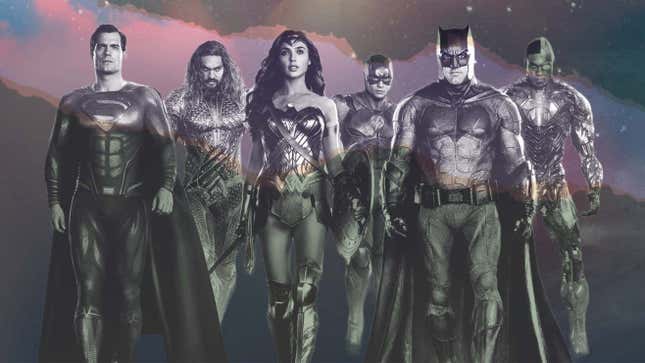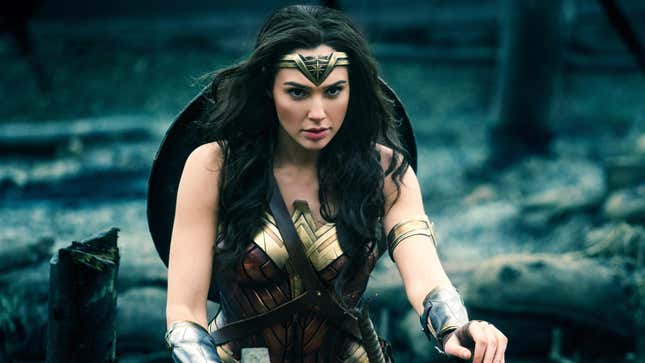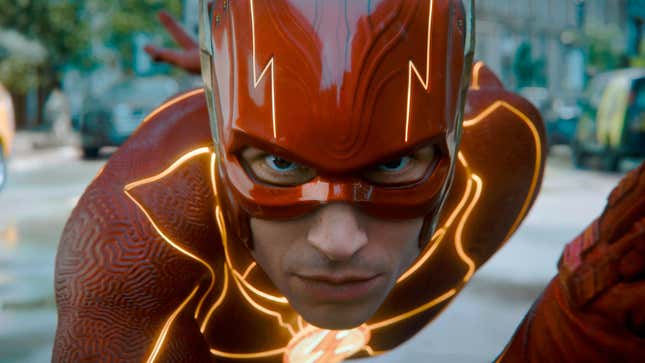
With his energies now focused on building his own original(-ish) science-fiction franchise, filmmaker Zack Snyder has put the superheroes of the DC universe behind him. And now that Aquaman And The Lost Kingdom is finally out in theaters, it’s time for audiences to do the same. It’s been a decade since Snyder’s Man Of Steel opened and launched a new era of DC superheroes on screen. Since then, we’ve gotten no less than 15 feature films connected to this shared universe—16 if you count the two cuts of Justice League separately—and though Snyder only directed three of them himself (and produced a handful of others), his moody aesthetic set the tone for everything that came after. As we head into a new year and DC Studios heads in a new direction under the leadership of James Gunn and Peter Safran, it’s a good time to pack up this era into a box and set it aside for future generations to discover and analyze with fresh eyes.
It was pretty clear from the outset that Snyder was far more interested in certain aspects of the Superman mythos—namely his awesome (in the archaic sense), godlike power—than others. Like many Very Serious Artists before him, Snyder sought to separate the characters from their pulpy, common origins in the pages of cheap comic books and elevate them into something more artsy and intellectual. No bright colors, quippy catchphrases, silly secret identities, or inspirational speeches from Pa Kent (instead, he lets himself be killed to teach his son a lesson). This version of Clark was more steel than man, and that should have told us everything we needed to know about where the franchise was headed. And yet, when Snyder’s next installment, Batman V Superman: Dawn Of Justice came out, it was an even bigger mess. But at least we’ll always have the infamous “both our moms are named Martha so let’s stop fighting” moment.
Here’s look back at the past decade of the DCEU films, sizing up what worked, what didn’t, and what never should have happened.
The Good
The DCEU was not without its triumphs, though. The first Wonder Woman soared to a healthy worldwide box-office total of $823 million, more than both Man Of Steel and Justice League and for a much smaller budget. Director Patty Jenkins kept the desaturated look to fit in with the rest of the franchise, but managed to incorporate heart and humanity in the moments between all the fighting. As a result, Diana came to the Justice League party as a more fully rounded character than her teammates. Not that it put all that characterization to good use.

The other notable female-led film in the DECU, Birds Of Prey (also known by the unmarketable title of Birds Of Prey And The Fantabulous Emancipation Of One Harley Quinn) was another critical success, thanks mainly to Margo Robbie’s total commitment to the role of Harley. It’s one of the few films in the franchise that let its characters be colorful and actually have some fun. Other examples include the original Shazam! and the recent Blue Beetle, both of which are aimed at a more of a family audience. As much as we tend to focus on the Justice League films, let’s not forget that some DC films that are proud to embrace the comic-book origins of their characters.
And then there are the two films most responsible for Gunn and Safran getting the job as co-heads of the studio: the moderately successful, by DC standards at least, Aquaman (which Safran produced) and the critically acclaimed but financially underperforming Suicide Squad (which Gunn directed). When Warner Bros. was looking to bring in new blood, they were the people the studio tapped.
The Bad
Nothing makes you appreciate the difference in the approach of the DCEU more than watching the two Suicide Squad films back to back (though honestly, we don’t recommend it). The first is poorly written and badly directed, wasting its talented cast (plus Jai Courtney and Cara Delevingne) in a boring, muddy, mess of a film. The second takes the premise to heart and actually lets its brigade of quirky antiheroes off the chain. It’s funny and weird and very gory—everything Gunn does well. Unfortunately, the first one left such a bad taste in everyone’s mouth that the audience wasn’t eager to go back for a second helping of a much better-made dish. The circumstances of its release simultaneously on streaming and in theaters in the wake of the Covid-19 pandemic didn’t help.
It’s always hard to disentangle the circumstances of a film’s production from what actually makes it to the screen, but when it comes to the Snyderverse, it’s an even trickier proposition. Justice League was supposed to be the jewel in the crown, the DCEU equivalent of The Avengers. Warner Bros. even brought in Joss Whedon to finish the project after Snyder’s departure to make sure of it. What they got instead was a public relations nightmare. Still, there’s no shortage of devoted fans who love Snyder’s particular brand of stylish bombast and will defend the film and the recut version of it with their dying breath.
The Ugly
With a studio and a franchise as mismanaged as this one, what happened with The Flash was perhaps inevitable. After delays in production, constantly shifting release dates, and its star’s legal troubles making headlines, the film finally came out in 2023, and wound up being one of the most disappointing films of the year. It was just another example of the toxicity and scandals that plagued Justice League. By that point, Gunn and Safran had already been announced as the new heads of DC Studios, and they did their best to hype the film, but there was always an undercurrent of them wanting to clear the decks for the new iteration of the DC film universe, whatever that may turn out to be.

Had The Flash been better received, it might have been a good excuse for the reset they were hoping for. Or maybe it’s a case of too little too late. The multiverse is no longer as new and shiny as it once seemed. Even Marvel has managed to beat its own version into the ground so hard that the studio diminished excitement for the prospect of bringing the X-Men into the MCU. Plus, it’s also hard to get invested in a character like Aquaman when it seems like he has no future in the new DC universe.
So as we look forward to 2024 and whatever Gunn and Safran have in store, let’s pour one out for the end of a wild and chaotic era for comic-book movies. We may never see its like again.